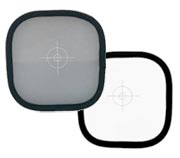Gray Card

The important things to remember are:




18 Percent Gray Card
One Comment ..
Many serious photographers consider a gray card an indispensable accessory. An 18 percent gray card is simply a flat, uniformly colored gray surface that is made to reflect 18 percent of the light that falls on it.
Though called a card, the material of a gray card may be something other than card stock.
Photographic light meters, including those found in digital cameras, are designed to read an 18 percent gray card as a neutral (middle tone) of gray and calculate the exposure needed to create an image of the card as a neutral tone midway between solid black and pure white.
Gray cards are useful in determining proper exposure and calibrating light meters.
Two-sided gray cards
Some gray cards come with a neutral white color on the reverse side. The white side is used to perform a custom white balance, though the gray side can be used too.
Most digital cameras have a built-in feature for taking a custom white balance. A photo is taken of the card to obtain optimal white balance for the lighting in an area. A white piece of paper or cloth can be used for a custom white balance. However, the reading may not be as accurate if the white is not a neutral white.
To obtain an accurate metering, the card must be held close enough to the camera lens so that only the card appears in the viewfinder. The reading is saved in the cameras memory until a new one is taken.
A custom reading helps ensure that photographs of a scene taken during the same photo shoot will be consistently exposed.
Gray and white cards come in a variety of styles and sizes, some small enough to fit in a camera bag. Larger ones may collapse into a smaller size for easier carrying.
When to use a gray card
-
•under difficult lighting conditions, such as when a subject is backlit or in the shade.
-
•when light illuminating a subject is artificial (eg.inside incandescent lighting) or when lighting is mixed.
-
•when photographing challenging scenes, such as sand and snow.
-
•when photographing of flat objects such as stamps, documents, paintings and photos.
-
•when photographing subjects with dark skin.
Tips for using a gray card
-
•the gray card should be placed near your subject to ensure that light illuminating the card matches the light falling on the subject.
-
•the viewfinder should be completely filled with the gray card before taking the reading.
-
•if lighting changes during a photo shoot, take a new reading.


Back to Main Photography page
Back to Main Pysankarstvo page
Search my site with Google
18% Gray Card




